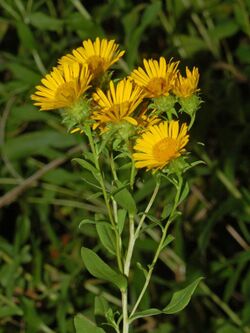Biology:Inula spiraeifolia
| Inula spiraeifolia | |
|---|---|

| |
| Scientific classification | |
| Kingdom: | Plantae |
| Clade: | Tracheophytes |
| Clade: | Angiosperms |
| Clade: | Eudicots |
| Clade: | Asterids |
| Order: | Asterales |
| Family: | Asteraceae |
| Genus: | Inula |
| Species: | I. spiraeifolia
|
| Binomial name | |
| Inula spiraeifolia L. 1759 not K.Koch ex Boiss. 1875
| |
| Synonyms[1] | |
| |
Inula spiraeifolia is a European species perennial herbaceous plant belonging to the genus Inula within the daisy family.
Description
Inula spiraeifolia reaches a height of 30–80 centimetres (12–31 in). The middle leaves are oblong-elliptic and they measure 3–5 centimetres (1.2–2.0 in) of length and 1–2 centimetres (0.39–0.79 in) of width. The base of the leaves is not embracing the stem. The upper cauline leaves are erect, with a round base. The stem is erect and branched, with numerous flowers (two to twelve). The outer ones are ligulate and bright yellow, while the inner ones are tubular dark orange. The flower's attachment to the stalk (receptacle) is covered by clearly curved scales. The flowering period extends from June to August.
Distribution
This plant is found in southern France, Italy, Switzerland , and the Balkans.[2]
Habitat
They can be found up to 700 metres (2,300 ft) above sea level, in most environments, rocky, arid and hot.[3]
References
- ↑ The Plant List, Inula spiraeifolia L.
- ↑ Altervista Flora Italiana, Inula spiraeifolia L. includes photos and European distribution map
- ↑ Pignatti S. - Flora d'Italia (3 vol.) - Edagricole – 1982. vol. III, pag. 44
External links
Wikidata ☰ Q2307896 entry

